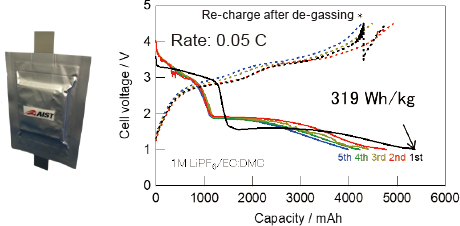Conversion-type Battery
Extremely high capacity can be achieved when Li+ insertion/deinsertion is carried out beyond the limits of the structural maintenance of the electrode materials. FeF3 is one such positive electrode material that enables the production of high-capacity, low-cost batteries in combination with metallic Li as the negative electrode. This battery system can be applied to xEVs and sustainable energy storage systems.
Features and Advantages
- High theoretical energy from a multi-electron reaction in the conversion electrode
- No oxygen evolution and improved safety
- Low-cost materials
R&D Themes
- Development of long-life and high-energy-efficiency positive electrode materials
- Development of long-life negative electrode structure and surrounding components
- Optimization of the overall cell design for balanced performance

R&D Strategies
- Positive electrode: understanding the source of large hysteresis during operation and improving the technology, as well as side-reaction suppression technology
- Negative electrode: understanding the area to be improved when considering the total cell reaction
- Electrolyte and inactive battery components suitable for electrode materials
Research Results
Developing a prototype cell of high performance through improving the FeF3 electrode process and its electrolyte

The prototype cell (6 Ah-class) and its charge–discharge curves, which demonstrated 319 Wh/kg energy density.

Improvement of energy efficiency using a composite with vanadate glass.

Understanding the degradation mechanism by applying advanced analysis technology.
